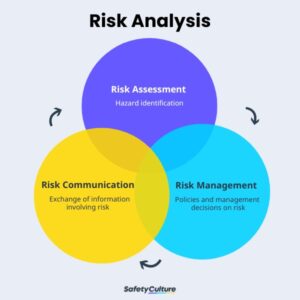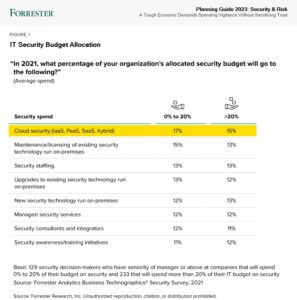The Critical Role of Risk Assessments in Cybersecurity
September 25, 2023
Under Attack? Contact Us

At the core of effective cybersecurity lies in comprehensive risk assessments. In the rapidly evolving digital landscape, cybersecurity threats pose an unavoidable risk. With businesses becoming increasingly digitized, the importance of implementing robust cybersecurity measures has never been more crucial.
As you may be aware, cyberattacks can have devastating consequences for businesses of all sizes. Ransomware attacks, in particular, can result in temporary shutdowns or even permanent closures. According to IBM’s Cost of a Data Breach Report 2023, the average financial impact of a data breach globally currently stands at $4.45 million, while U.S. companies face an even higher cost of $9.44 million. This represents a significant increase of 15.3% from $3.86 million in 2020, just a few years ago. It is crucial for organizations to fully comprehend the severe consequences and proactively implement measures to safeguard their invaluable assets.
Yikes.
If you run a small to mid-sized business, you may think that cybercriminals will pass you by in search of bigger payouts. Unfortunately, this is not the case. Nearly half of reported cyberattacks happen to small and medium-sized businesses. Attackers target smaller businesses guessing they will be easier to penetrate than large enterprises. Indeed only 43% of cyberattacks are aimed at small businesses; however, only 14% of small businesses are prepared to defend themselves, according to stats provided by the 2023 Verizon Data Breach Investigation Report.
Are you one of them?
The only defense against cyberattacks is a comprehensive cybersecurity plan that continuously monitors your system and assesses threats, and a professional security risk assessment is the cornerstone of any cybersecurity program.
No matter how good your network security is, effective cyber defense is not a “set it and forget it” process. Hackers are constantly coming up with new ways to breach systems and fool employees. To combat this, your company must be regularly informed and educated on the best ways to prevent these attacks before they can happen.
All cybersecurity plans should include regularly scheduled cybersecurity risk assessments to vet your network for vulnerabilities and make sure your team is prepared to deal with a breach should one occur.

Risk Analysis Framework example: SafetyCulture
Risk assessments in cybersecurity is a methodical approach to identifying, analyzing, and evaluating potential risks that could compromise your organization’s information security. This process is not just about identifying potential threats but also determining their impact and the probability of their occurrence.
Risk assessments are a critical element of any cybersecurity strategy, offering invaluable insights that help organizations make informed decisions about their cybersecurity measures. It helps identify vulnerabilities, assess the potential impact of a cyberattack, and prioritize areas for improvement.
Risk assessments are used to evaluate all the security measures in place across an entire network. The assessment identifies vulnerabilities in a network’s security and determines the level of risk created by those weaknesses. The risk to each individual team or department should be considered, as well as how vulnerable the company is as a whole.
A good risk assessment should do more than just alert you to current problems with network security; it should also help predict possible outcomes if issues are not addressed, as well as provide solutions to take action on.
Risk assessments serve a crucial role in strengthening an organization’s resistance against cyber threats. Here’s why:
Hackers and other cybercriminals are constantly on the lookout for ways into any poorly guarded network. A risk assessment will identify those weak areas, whether they be in the software, hardware, or due to the human component.
Risk assessments can guide decision-makers on where to invest resources for maximum security impact. Once potential problems have been identified, you have the opportunity to fix the issues before they can be exploited. Whether the issue is outdated software or inadequately trained staff, you now have the chance to make things right and prevent a breach.
While it is common for employees to assume that cybersecurity falls solely under the purview of the IT team, the truth is that safeguarding your network requires the vigilance of every member of your workforce. Undoubtedly, the IT team plays a pivotal role in ensuring network security, but the responsibility extends to each and every employee.
Conducting a comprehensive risk assessment serves the purpose of illustrating the daily threats that pose a risk to your company. Equipped with this knowledge and empowered by the impact they can have, all employees can integrate cybersecurity best practices into their daily routines. By doing so, they contribute to the overall cybersecurity hygiene of the organization.
Conducting regular risk assessments can ultimately result in considerable financial savings. A comprehensive assessment of all risks will help you identify where to put your resources for maximum security impact. By investing in the right areas, and cutting back on those that are unnecessary, you can save time and money in equal measure.
Protecting the budget is at the heart of almost every decision a business owner makes. Every expenditure has to be weighed against the benefit it will bring.
In a digital age, security is often the deciding factor in who wins a slice of the market. Risk assessments are essential for evaluating the current state of your security and identifying areas that may need improvement.
By conducting regular risk assessments, you can stay ahead of the curve, better protect your data and customer information, and put your business on a path to success.
“The global cost of a data breach for mid-market companies is $3.31 million; with each compromised record averaging $164 in expense.”
Cyberattacks can be devastating for companies in many ways. Not only is there the real cost of having to shut down temporarily, repair the damage, and possibly pay a ransom, but there is also the cost to your reputation to consider.
Today, every company has the potential to be a global player. This also means that every consumer has a multitude of companies to choose from when in search of a particular service or product. If a cyberattack creates a situation in which your customers are displeased, either because of delays, subpar production, or worst of all, a breach of their private information, it’s quite likely they will look to your competitors for future purchases.
The potential financial and reputational cost of a cyberattack is much higher than the cost of good cybersecurity — and that starts with a holistic risk assessment.
The recommendation for how often cybersecurity risk assessments should be carried out varies between companies and industries. The risk of a cyberattack is great for every industry, but for some industries that handle sensitive data, such as healthcare and finance, the stakes are often higher.
For most small to mid-sized companies, an annual checkup of their cybersecurity is probably enough. However, technology changes rapidly and so do the threats to network security, so some flexibility regarding risk assessment schedules should be considered.

Forrester IT security budget allocation in 2021
When it comes to safeguarding your company from cyberattacks, there are no hard and fast rules dictating how much to spend. For an average company with moderate risk, it is advisable to allocate 15-20% of your IT budget to cybersecurity.
Although it may seem like a significant investment for something that may go unnoticed unless it fails, it’s crucial to remember that this is precisely the point. Cybersecurity is an ongoing effort that necessitates constant vigilance from a team of experts to prevent and detect cyberattacks.
If employing a full-time team of IT security professionals is beyond your means, outsourcing the work to a specialized firm dedicated to protecting clients from cyberattacks could be a viable option.
A regular cybersecurity risk assessment should be an integral part of any comprehensive security plan. Considering the potentially catastrophic costs associated with a cyberattack, there should be no doubt that investing in an effective cybersecurity plan now is well worth the financial commitment.

Cybersecurity is customized, tailored to your business needs.
Every organization is unique, and so are its cybersecurity needs. A one-size-fits-all approach to cybersecurity simply won’t cut it. Having holistic security that is tailored to suit your business needs is crucial. This is where risk assessment comes into play. By understanding your organization’s specific vulnerabilities, you can tailor your cybersecurity measures to address these risks effectively.
“Developing and implementing tailored cybersecurity plans and processes is key to protecting and maintaining business operations.” CISA
In the world of cybersecurity, risk assessments are not just theoretical exercises; they are practical tools that organizations can use to strengthen their security measures. Let’s take a look at a case study where successful risk assessments have played a crucial role in protecting organizations from cyber threats. Read the FilmRise Case Study to learn more!
In today’s digital age, a proactive approach to cybersecurity is key. Don’t wait for a cyberattack to compromise your organization’s information security. Conduct a risk assessment today and take the first step towards a more secure future.
Remember, cybersecurity is a team sport. Cybersecurity is not just about preventing threats but also managing them effectively when they occur. Start your risk assessment journey today and build a robust cybersecurity strategy that keeps your business safe.
At Cyber Defense Group, we specialize in providing tailored cybersecurity solutions that meet your specific needs. Contact us today to learn how our expertise can help you minimize your cybersecurity risks.
Liked what you read here? Then be sure to share with your co-workers and friends! You can also follow us on Twitter / X @CyberDefGroup or find us on LinkedIn.
Copyright © 2024 CDG. All Rights Reserved